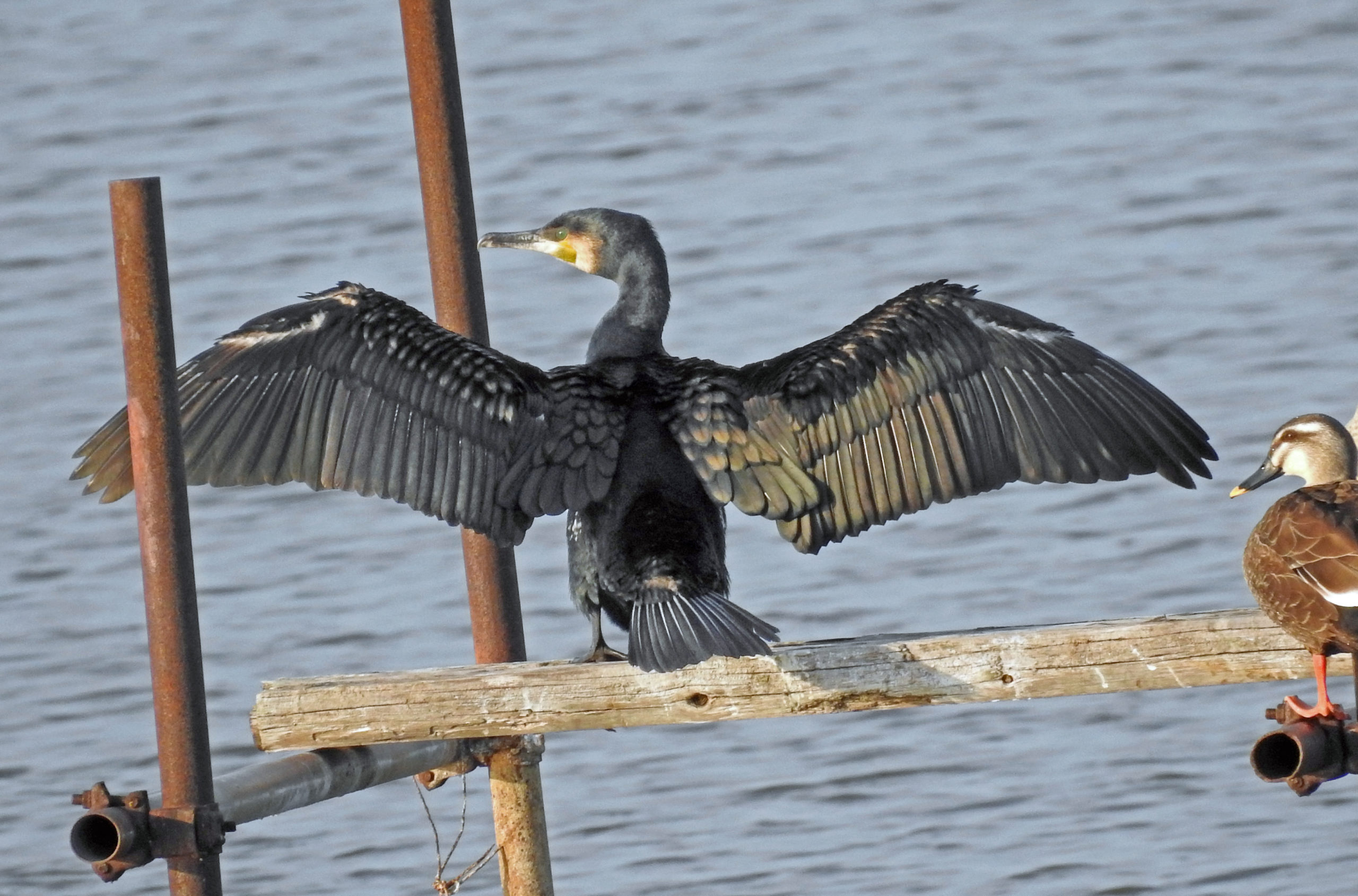Another warm day. I get an early start, planning an ambitious ride down the Shinkawa River bike path to Tokyo Bay to look for migratory sandpipers and plovers on the flats. Nice idea, but not even close. I find myself pedaling furiously into a powerful wind from the south and southwest. I’m only doing 8~9 km/h on stretches where I usually do 22~23. The only option is to do a 180 and head back home. Sandpipers and plovers would have been nice, but I get consolation in watching the great cormorants on the pond next to our house.
Great cormorants are big, sturdy birds, glossy black with a bronze tint on their wing feathers. Their cheeks are white, and they sport a bright yellow patch of bare skin on their faces. During the breeding season adults have short white plumes on their head and necks. Most people think of them as nondescript or even ugly birds, but that’s because they have never gotten close enough to appreciate their incredible sea-green eyes!
Cormorants engage in a form of feeding that ornithologists call ‘underwater pursuit’. They dive under the surface and actively chase after fish. I have clocked them underwater for more than a full minute. A cormorant’s bill is long, thin, and hooked at the tip, ideal for snaring and holding slippery fish. The legs are positioned way to the rear of the body, to provide maximum forward thrust when swimming. Heavy-bodied, these birds present a low profile when floating at the surface.
As might be expected, cormorants’ superb adaptation to underwater pursuit has come with a few trade-offs. To begin with, their heavy bodies make it hard to take off from the water surface. They need to run for a few dozen meters, kicking the water and building up speed like a jumbo jet, before lifting off into a shallow glide. In addition, the leg positioning, while ideal for underwater swimming, makes walking on land a bit cumbersome. Cormorants tend to fly directly from the water surface to perching points on trees or wharfs.

To further increase their body weight a bit, cormorants allow their feathers to absorb some water. After a while, they need to stop and dry these feathers out in the sun. Cormorants perched with their wings held out to dry are a common sight on lakes, rivers, and coasts.

Great Cormorants (Phalocrocorax carbo) are distributed throughout the Eurasian continent. The Japanese birds comprise one of several regional subspecies. Japan’s cormorant populations decreased drastically during the 1950s and 1960s, due to widespread use of toxic agricultural chemicals and industrial pollution of rivers and lakes. By 1970 only a few thousand birds remained nationwide, in just 3 breeding colonies. The best known of these was at Shinobazu Pond in Ueno Park in central Tokyo. At this stage ornithologists were worried that the Japanese subspecies would go extinct.
Fortunately, helped along by restrictions on agricultural poisons and better water quality standards, the Japanese cormorants began recovering. Today’s population is estimated at about 150,000, and the subspecies is no longer considered endangered. In fact, in some areas they have increased so much that local fishermen now consider them a nuisance. Cormorants are said to consume up to 500 grams of fish a day. In addition, winter roosts and breeding colonies are despised for their odor and excrement.
There are four species of cormorant found in Japan, two of which, the great cormorant and the Japanese cormorant (P. capillatus), are very common. These two species are respectively called kawa-u, or ‘river cormorant’ and umi-u (u is the generic term for cormorant), or ‘ocean cormorant’, in Japanese. Interestingly, despite their names, it is the umi-u, and not the kawa-u, that is used in Japan’s famous ukai cormorant fishing. Kawa-u inhabit inners bays, lakes, and the placid lower reaches of rivers. They are accustomed to hunting in relatively calm waters, and are thus not suited to the fast-flowing rivers where cormorant fishing is practiced. Umi-u, on the other hand, normally hunt in high ocean waves and strong currents, and are thus better adapted to the cormorant fishing rivers.
A substantial colony of great cormorant live all year round on the pond next to my condominium. From spring through summer they join the herons and egrets in a huge communal nesting site. With communal nesting, the general rule is the more the merrier. Larger colonies can muster more troops for defending against predators such as jungle crow and northern goshawk.
